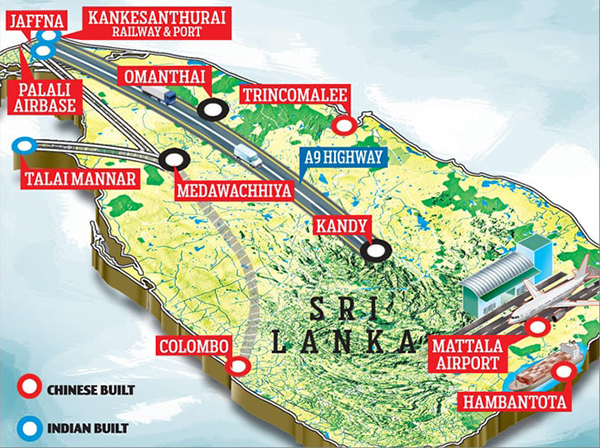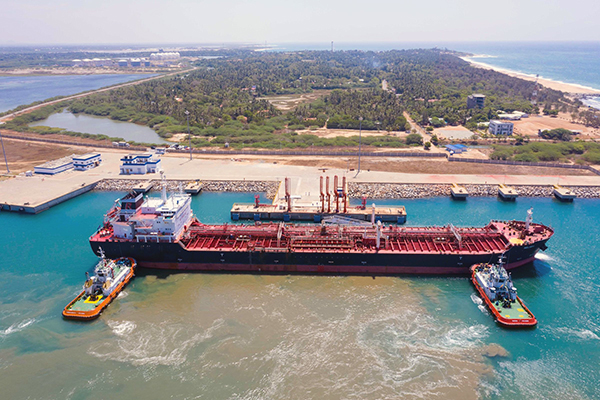Chinese Influence in India’s Neighbourhood (Part 1)
China has been pursuing a strategy to acquire influence in small island nations in the Indian Ocean Region (IOR), particularly through its Belt and Road Initiative (BRI). The BRI is a massive infrastructure development project that aims to connect Asia, Europe, and Africa through a network of roads, railways, ports, and other infrastructure projects.
In the IOR, China has been investing in infrastructure projects, such as building ports and airports, in small island nations like Sri Lanka, the Maldives, and Pakistan. These investments have been met with both praise and criticism, with some seeing them as a way to boost economic development and connectivity, while others see them as a way for China to gain strategic footholds in the region and exert greater influence.
Critics have also raised concerns about the sustainability and feasibility of these projects, as well as the potential for debt-trap diplomacy. Additionally, there are concerns that these projects may not serve the best interests of the host countries and could lead to increased dependence on China.
China has also been increasing its presence in the IOR through its naval and coast guard vessels, which have been patrolling the waters and protecting its shipping lanes. This has raised concerns among other countries in the region and around the world, as it may be perceived as a way for China to assert its military and economic power in the region.
Influence in Sri Lanka
China has been increasing its influence in Sri Lanka through a variety of means. One key way has been through infrastructure development projects, particularly those associated with the Belt and Road Initiative (BRI). These projects include the construction of ports, airports, and highways, and are aimed at boosting economic development and connectivity in Sri Lanka.
One of the most notable infrastructure projects in Sri Lanka is the development of the port of Hambantota, which China has invested in and now operates. This has been met with criticism from some, as the port has been seen as a debt trap for Sri Lanka, and has raised concerns about China’s increasing control over strategically important infrastructure in the country.
China has also been investing in other infrastructure projects in Sri Lanka such as the Colombo International Financial City, and the Mattala Rajapaksa International Airport.
Another way China has been increasing its influence in Sri Lanka is through trade and investment. China is one of Sri Lanka’s top trading partners and investors, which has helped to boost the small island nation’s economy.
China has also been increasing its presence in Sri Lanka through its military and coast guard vessels, which have been patrolling the waters around the island nation and protecting its shipping lanes. This has raised concerns among other countries in the region and around the world, as it may be perceived as a way for China to assert its military and economic power in the region.
China’s Debt Trap
There are concerns that China has trapped Sri Lanka in a debt trap through infrastructure development projects, and that this may give China strategic advantages in the IOR, which could threaten India’s security. The Sri Lankan government, however, denies these claims and China has denied the use of debt-trap diplomacy.
One example is the development of the port of Hambantota. In 2010, Sri Lanka agreed to a deal with China to develop the port, which included a loan from China for $361 million. However, the port failed to generate enough revenue to cover the loan payments and Sri Lanka was unable to repay the debt. In 2017, as a result, Sri Lanka was forced to lease the port to China for 99 years to repay the debt.
This has raised concerns that the port, which is located close to India’s southern coast, could be used for military purposes by China, giving it a strategic advantage in the IOR and potentially threatening India’s security.
Another example is the Colombo International Financial City and the Mattala Rajapaksa International Airport, which were built with Chinese loans but have also failed to generate enough revenue to repay the debt.
Critics argue that this is a pattern of “debt-trap diplomacy” by China, in which it provides loans for infrastructure projects to developing countries, and then, when those countries are unable to repay the debt, uses that as leverage to gain control over strategically important assets.
It is worth noting that Sri Lanka has denied that this is the case and that it has not fallen into a debt trap. Furthermore, China has denied using debt-trap diplomacy, stating that the projects were agreed upon mutually and that the loans were offered on commercial terms.
India’s concerns over Chinese influence
India has expressed concerns over China’s increasing influence in Sri Lanka, particularly in the areas of infrastructure development and military presence.
One of the main concerns is the Hambantota port, which India sees as a potential military threat as it is located close to India’s southern coast. India fears that China may use the port for military purposes.
India has also been concerned about the Colombo International Financial City and the Mattala Rajapaksa International Airport, as it sees these projects as a way for China to gain greater economic and strategic control over Sri Lanka.
India is also worried about China’s growing military presence in Sri Lanka, as Chinese naval and coast guard vessels have been increasingly patrolling the waters around the island nation. This has raised concerns that China may be seeking to assert its military and economic power in the region.
India has responded to Chinese influence in Sri Lanka by increasing its own engagement with the island nation, through economic and development assistance, and by strengthening its own military presence in the IOR.
Chinese submarine visits to Sri Lanka
India has expressed concerns over the increasing frequency of Chinese submarine visits to Sri Lanka. These visits, which have occurred several times in recent years, are seen as a potential threat to India’s security and strategic interests in the IOR.
One concern is that these submarine visits could give China a military advantage in the region, as submarines are equipped with advanced stealth technology and can be used for a variety of purposes, including reconnaissance, intelligence gathering, and power projection.
Another concern is that these visits could be part of a larger strategy by China to establish a foothold in the IOR.
India has also raised concerns about the potential for these submarine visits to be used for espionage or sabotage, as submarines are able to operate covertly and can access sensitive areas undetected.
In response to these concerns, India has also been building stronger ties with other countries in the region, such as the United States, Japan, and Australia, to counterbalance China’s growing influence.
Chinese spy ship visit to Sri Lanka
India has expressed concerns over Chinese spy ship visits to Sri Lanka, as these ships are equipped with advanced surveillance technology and can be used for intelligence gathering and monitoring activities in the IOR.
India is worried that these visits could be used to gather intelligence on India’s naval movements and military capabilities, as well as on its economic and political activities in the region. The Indian government is also concerned that these visits could be used to interfere with its trade and energy security in the region.
India is also worried about the potential for these spy ships to support the Chinese naval presence in the Indian Ocean, which could be used to assert China’s military and strategic interests in the region.
Chinese military aid to Sri Lanka
China has provided military aid to Sri Lanka in the form of equipment, training, and technical assistance. This aid has been provided to help Sri Lanka improve its defense capabilities and maintain internal security.
China has provided a range of military equipment to Sri Lanka, such as artillery, small arms, and naval vessels. It has also provided training and technical assistance to Sri Lankan military personnel in areas such as counter-terrorism, peacekeeping, and maritime security.
China’s military aid to Sri Lanka has been met with both praise and criticism. Some have welcomed it as a way to help Sri Lanka improve its defence capabilities and maintain internal security, while others have criticized it as a way for China to gain strategic footholds in the region and exert greater influence.
Critics have also raised concerns about the sustainability and feasibility of this aid, as well as the potential for it to be used to support human rights abuses by Sri Lankan government.
Indian military aid to Sri Lanka
India has provided military aid to Sri Lanka in the form of equipment, training, and technical assistance, which has been motivated by its desire to promote stability in the region and to counterbalance the influence of other countries. The aid has been met with mixed reactions, with some seeing it as a way to help Sri Lanka improve its defence capabilities and maintain internal security, while others view it as a way for India to exert greater influence in the region.
India has provided a range of military equipment to Sri Lanka, such as artillery, small arms, and naval vessels. It has also provided training and technical assistance to Sri Lankan military personnel in areas such as counter-terrorism, peacekeeping, and maritime security. Some of the prominent items of military aid have been:
Small arms and ammunition. India has provided small arms such as rifles and pistols, as well as ammunition to Sri Lanka to help improve its defense capabilities.
Artillery. India has provided artillery equipment, such as howitzers and mortars, to Sri Lanka to help improve its artillery capabilities.
Naval vessels. India has provided naval vessels, such as patrol boats and fast attack craft, to Sri Lanka to help improve its maritime security capabilities.
Radars and surveillance equipment. India has provided radars and other surveillance equipment to Sri Lanka to help improve its coastal and maritime surveillance capabilities.
Training and technical assistance. India has provided training and technical assistance to Sri Lankan military personnel in areas such as counter-terrorism, peacekeeping, and maritime security.
India has also been concerned about the potential for terrorism and extremism in Sri Lanka, and has provided aid to help Sri Lanka combat these threats.



















